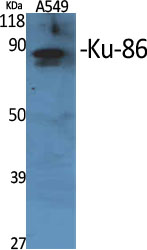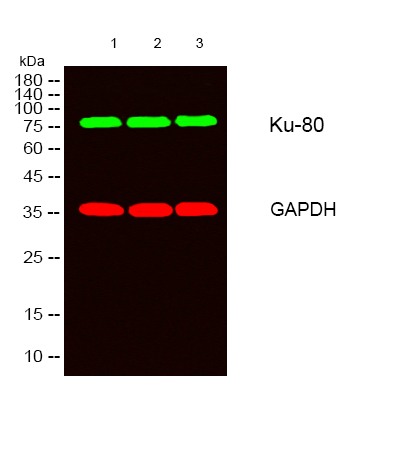JAK3 (Phospho Tyr904) rabbit pAb
- Catalog No.:YP1778
- Applications:WB
- Reactivity:Human;Mouse;Rat
- Target:
- JAK3
- Fields:
- >>Chemokine signaling pathway;>>PI3K-Akt signaling pathway;>>Necroptosis;>>Signaling pathways regulating pluripotency of stem cells;>>JAK-STAT signaling pathway;>>Th1 and Th2 cell differentiation;>>Th17 cell differentiation;>>Hepatitis B;>>Measles;>>Human T-cell leukemia virus 1 infection;>>Epstein-Barr virus infection;>>Pathways in cancer;>>Viral carcinogenesis;>>Non-small cell lung cancer;>>Primary immunodeficiency
- Gene Name:
- JAK3
- Protein Name:
- JAK3 (Phospho-Tyr904)
- Human Gene Id:
- 3718
- Human Swiss Prot No:
- P52333
- Mouse Gene Id:
- 16453
- Mouse Swiss Prot No:
- Q62137
- Rat Swiss Prot No:
- Q63272
- Immunogen:
- Synthesized peptide derived from human JAK3 (Phospho-Tyr904)
- Specificity:
- This antibody detects endogenous levels of JAK3 (Phospho-Tyr904) at Human, Mouse,Rat
- Formulation:
- Liquid in PBS containing 50% glycerol, 0.5% BSA and 0.02% sodium azide.
- Source:
- Polyclonal, Rabbit,IgG
- Dilution:
- WB 1:500-2000
- Purification:
- The antibody was affinity-purified from rabbit serum by affinity-chromatography using specific immunogen.
- Concentration:
- 1 mg/ml
- Storage Stability:
- -15°C to -25°C/1 year(Do not lower than -25°C)
- Other Name:
- Tyrosine-protein kinase JAK3 (EC 2.7.10.2) (Janus kinase 3) (JAK-3) (Leukocyte janus kinase) (L-JAK)
- Molecular Weight(Da):
- 124kD
- Background:
- The protein encoded by this gene is a member of the Janus kinase (JAK) family of tyrosine kinases involved in cytokine receptor-mediated intracellular signal transduction. It is predominantly expressed in immune cells and transduces a signal in response to its activation via tyrosine phosphorylation by interleukin receptors. Mutations in this gene are associated with autosomal SCID (severe combined immunodeficiency disease). [provided by RefSeq, Jul 2008],
- Function:
- catalytic activity:ATP + a [protein]-L-tyrosine = ADP + a [protein]-L-tyrosine phosphate.,disease:Defects in JAK3 are a cause of severe combined immunodeficiency autosomal recessive T-cell-negative/B-cell-positive/NK-cell-negative (T(-)B(+)NK(-)SCID) [MIM:600802]. SCID refers to a genetically and clinically heterogeneous group of rare congenital disorders characterized by impairment of both humoral and cell-mediated immunity, leukopenia, and low or absent antibody levels. Patients with SCID present in infancy with recurrent, persistent infections by opportunistic organisms. The common characteristic of all types of SCID is absence of T-cell-mediated cellular immunity due to a defect in T-cell development.,domain:Possesses two phosphotransferase domains. The second one probably contains the catalytic domain (By similarity), while the presence of slight differences suggest a different role
- Subcellular Location:
- Endomembrane system ; Peripheral membrane protein . Cytoplasm .
- Expression:
- In NK cells and an NK-like cell line but not in resting T-cells or in other tissues. The S-form is more commonly seen in hematopoietic lines, whereas the B-form is detected in cells both of hematopoietic and epithelial origins.
- June 19-2018
- WESTERN IMMUNOBLOTTING PROTOCOL
- June 19-2018
- IMMUNOHISTOCHEMISTRY-PARAFFIN PROTOCOL
- June 19-2018
- IMMUNOFLUORESCENCE PROTOCOL
- September 08-2020
- FLOW-CYTOMEYRT-PROTOCOL
- May 20-2022
- Cell-Based ELISA│解您多样本WB检测之困扰
- July 13-2018
- CELL-BASED-ELISA-PROTOCOL-FOR-ACETYL-PROTEIN
- July 13-2018
- CELL-BASED-ELISA-PROTOCOL-FOR-PHOSPHO-PROTEIN
- July 13-2018
- Antibody-FAQs
- Products Images

- Western Blot analysis of various,using primary antibody at 1:1000 dilution. Secondary antibody(catalog#:RS23920) was diluted at 1:10000

